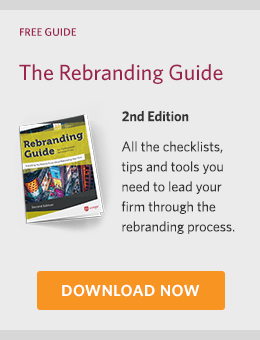A brand is a complex organism. This is part six in a series of articles in which we examine a successful brand’s component parts.
Ah, the poor, misunderstood logo. People put a lot of pressure on its narrow shoulders. Let’s begin by sweeping away a couple of common misconceptions. Your logo is not your brand. And it’s not a portrait in miniature of your business. So don’t expect it to communicate much, if anything, about what you do. Those disclaimers aside, a logo can be the anchor of a firm’s visual identity and a critical component of a successful brand.
As part of an overall brand approach, firm logos serve three primary functions:
- Identification
- Differentiation
- Aiding recall
Let’s look at each of these attributes in turn.
1. Identification
A logo exists to represent and identify a company or product. The brand name tells us what it is called. The mark (if there is one) helps us recognize the brand the next time we encounter it.

2. Differentiation
An effective logo visual separates a firm from the rest of the field. Perceptions are built little by little over time, and a logo that takes a different tack from the competition will contribute to the distinctiveness of a firm’s brand image. In addition, a logo design sometimes can convey aspects of a company’s personality or attitude (for instance, fun, warmth, or energy).
3. Aiding Recall
A distinctive logo is a memorable logo. Being noticed and remembered is the first step a firm must take en route to eventual selection and brand preference. The logo’s mark, if any, provides a shortcut that helps us identify a company or product in a hurry. We are all in a rush these days, and a well-conceived mark makes recognition easier.
Logo Anatomy
Most firm logos can be broken into two parts: the name and the mark (sometime called its symbol or icon). The name is obvious enough: it’s the company or product name rendered in type. Skillful logo designers will spend a great deal of time choosing a typeface, often customizing its letter forms to make the name more personalized and proprietary.
The mark, usually separated slightly from the name, supports the brand name and offers a visual dimension to the brand identity experience. Some marks have become so well known that they’ve practically replaced the brand name itself (think Nike’s swoosh and Apple’s apple). The danger here is that eventually the connection to the brand name may become disengaged. Anybody remember a certain musician from Minneapolis formerly known as a symbol? Well, that didn’t last long — once Prince got his name back, we knew what to call him again. Whew!
Download the NEW Rebranding Guide – Second Edition
Not all firm logos have marks. In fact, many successful businesses do just fine without one: Deloitte, IBM, and Oracle, for instance. This type of identifier, in which the name is the logo, is called a logotype. Logotypes do have a couple of drawbacks. Because they have to be read, legibility is critical, whether they appear on the web or in the distance on the side of a building. Logotypes also have a generic quality to them, so if a competitor were to adopt a similar-looking typeface it could create confusion in the marketplace. Nevertheless, many great brands have dispensed with marks and still gone on to do great things.
SEE ALSO: How to Choose a New Company Name, Logo and Tagline
The Redesign Dilemma
So is a logo redesign worth the effort? If you care about giving your business every advantage in the marketplace, you should consider your logo as a starting point. We live in a visual world, and every prospect that you contact is likely to see it. So pull up your website and ask yourself these questions about your current logo:
- Does it reflect your firm’s personality?
- Is it different from other logos in your industry?
- Is anyone going to notice it and remember you because of it?
If you answered “no” to any of these questions, you may want to think about revisiting your logo and taking your brand image in a new direction. A logo redesign is not a small undertaking — it will affect every piece of collateral and signage you have. But it takes an upfront investment to reap long-term rewards.
Download the NEW Rebranding Guide – Second Edition
Classifying Logos
Logos can be sorted into a few basic categories. The five categories below will give you a way to think about your current logo and what you might want your new logo to be.
- Logotypes | A company name rendered in distinctive typography is the primary graphic element in these logos. Successful logotypes are bold and easy to read. Accenture, Deloitte and Exxon are good examples.
- Monograms | A monogram is a mark made up of a company’s initials (think IBM, McDonalds, and GE).
- Abstract Marks | Nonrepresentational marks that accompany a business’s name. (Sometimes, however, these marks can reflect a company’s name or other non-service-related attribute: Apple, Cisco, Dewberry.) Examples of abstract marks include Chase, BP, PWC, and Symantec.
- Descriptive Marks | Iconic representations of a company’s products, services or defining character. Because these marks can be limiting and generic looking, they are becoming rare in the corporate world. The National Cotton Council of America logo is a well-executed example.
- Seals | Type and an icon are contained inside a shape, usually a circle, oval, shield, or rectangle. Because of their limited legibility and dated appearance, seals are becoming less common. Many state and federal agencies still use seals, but they are rare in the business world.
Read Earlier Posts in This Series:
- Elements of a Successful Brand 1: Brand Positioning
- Elements of a Successful Brand 2: The Tagline
- Elements of a Successful Brand 3: Personality
- Elements of a Successful Brand 4: Brand Promise
- Elements of a Successful Brand 5: The Name
- Elements of a Successful Brand 6: The Logo
- Elements of a Successful Brand 7: Color
- Elements of a Successful Brand 8: Messaging
- Elements of a Successful Brand 9: Imagery
Additional Resources
- Our Rebranding Kit gives you the tools and knowledge you need to lead your firm through a rebranding.
- Get strategies, tips, and tools for developing your firm’s brand with Hinge’s Brand Building Guide for Professional Services Firms.
- Download a free copy of the book Inside the Buyer’s Brain to learn how to build a powerful brand to help your firm close more sales.
How Hinge Can Help
Develop rebranding strategies that better connect with existing clients and prospects. Hinge’s Branding Program can help your firm stand out from the competition and build a brand that drives sustained growth.


